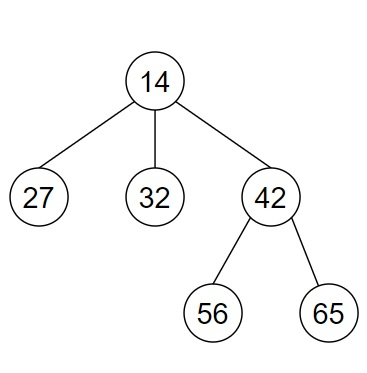
 Data Structure
Data Structure Networking
Networking RDBMS
RDBMS Operating System
Operating System Java
Java MS Excel
MS Excel iOS
iOS HTML
HTML CSS
CSS Android
Android Python
Python C Programming
C Programming C++
C++ C#
C# MongoDB
MongoDB MySQL
MySQL Javascript
Javascript PHP
PHP
- Selected Reading
- UPSC IAS Exams Notes
- Developer's Best Practices
- Questions and Answers
- Effective Resume Writing
- HR Interview Questions
- Computer Glossary
- Who is Who
Program to find the root of a n-ary tree in Python
Suppose, we are given the nodes of an n-ary tree in an array. We have to find and return the root node of the tree by reconstructing it. The full tree has to be displayed from the returned node in preorder notation.
So, if the input is like

then the output will be
[14, 27, 32, 42, 56, 65]
We will use the root of the tree to display the pre order traversal of the tree. So, the output is a pre order traversal of the tree.
To solve this, we will follow these steps −
indegree := a new map containing integer values
-
for each node in tree, do
-
for each child in children pointers of the node, do
indegree[value of child] := indegree[value of child] + 1
-
-
for each node in tree, do
-
if indegree[value of node] is same as 0, then
return node
-
return null
Example (Python)
Let us see the following implementation to get better understanding −
import collections
class Node:
def __init__(self, value, child = None) -> None:
self.val = value
self.children = []
if child != None:
for value in child:
self.children.append(value)
def solve(tree):
indegree = collections.defaultdict(int)
for node in tree:
for child in node.children:
indegree[child.val] += 1
for node in tree:
if indegree[node.val] == 0:
return node
return None
def treeprint(node, tree):
if node == None:
tree.append("None")
return tree
if tree == None:
tree = []
tree.append(node.val)
for child in node.children:
treeprint(child, tree)
return tree
node6 = Node(65)
node5 = Node(56)
node4 = Node(42, [node5, node6])
node3 = Node(32)
node2 = Node(27)
node1 = Node(14, [node2, node3, node4])
tree = [node2, node1, node5, node3, node6, node4]
root = solve(tree)
print(treeprint(root, None))
Input
node6 = Node(65) node5 = Node(56) node4 = Node(42, [node5, node6]) node3 = Node(32) node2 = Node(27) node1 = Node(14, [node2, node3, node4]) tree = [node2, node1, node5, node3, node6, node4]
Output
[14, 27, 32, 42, 56, 65]

